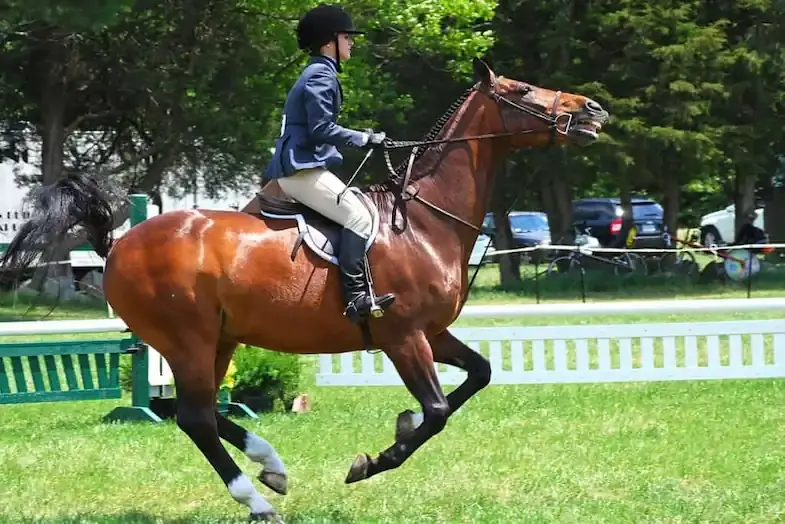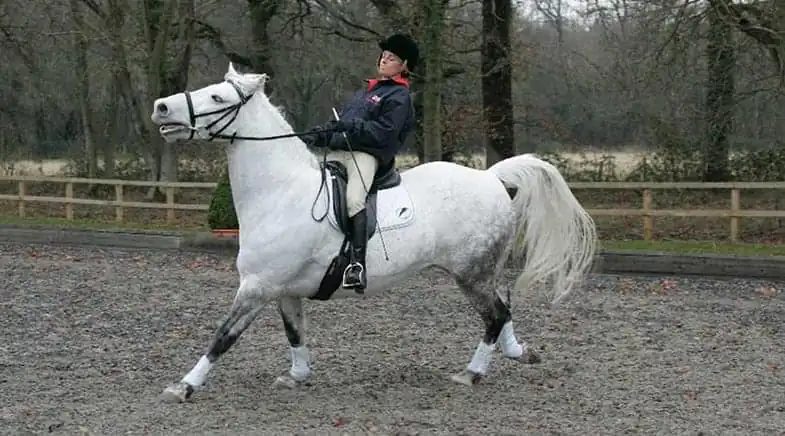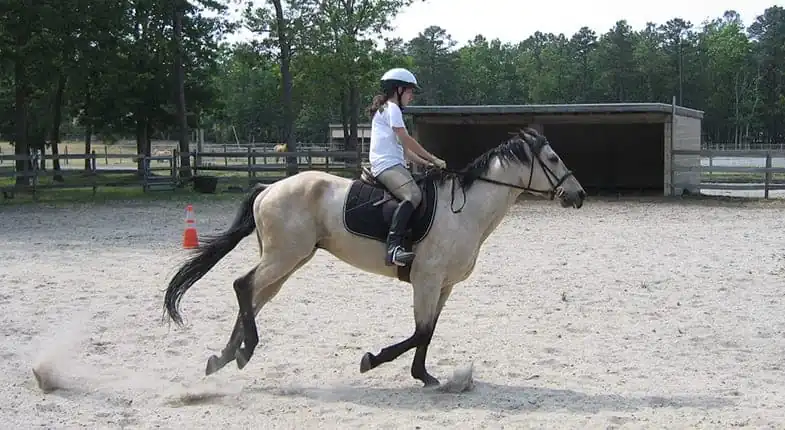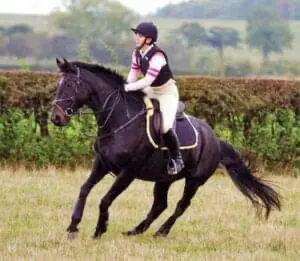When a horse bolts he’s in a blind panic, galloping as fast as he can, without responding to the rider’s pressure. He’s running on his instincts and isn’t paying attention to where he’s going or even to his footing which can be dangerous for both the horse and the rider (as well as anybody the horse may collide with). This is why it’s crucial to be calm, prepared, and to eventually, understand why your horse bolted in the first place. That way you can hopefully prevent it from happening again.
Bolting can be a frightening experience for both horse and rider, but the best thing you can do is relax and ride your horse rather than try and stop him. This will help him to keep his balance as well as not exaggerate his fears and anxieties.
What causes a horse to bolt?
You might think that your horse is crazy and has bolted for no reason at all but to your horse, it’s a natural reaction to a perceived threat, it’s his survival instincts kicking in. The key to understanding why your horse has bolted is to understand how his mind works. In most cases, bolting is a last resort because every other option has been exhausted.
If your horse feels trapped, whether because he sees a trailer as a scary place with no escape route or because he’s been on stall rest for months, he can suddenly bolt as a way of avoiding the situation. The same can be said for horses that have been startled or are suffering from some sort of pain, bolting, in their mind at least, is a way of trying to escape the pain.
No horse will bolt without a reason, although the reason may not be evident immediately. That said though the most common reasons a horse will bolt are:
- Startled – Horses are flight animals which is why their instincts are to run when something frightens them, it’s what’s kept them alive for so long. After all, if you’re not sure if something is going to try and kill you wouldn’t you run rather than stay and find out?
- Pain – While horses won’t initially bolt when they’re in pain they will if the pain isn’t dealt with. In part, because they want to escape the pain but also because they’ve tried every other way of telling us.
- Trapped – If a horse feels that he’s been backed into a corner, either literally or metaphorically, he may bolt as a way of getting free. The same can also be said for horses that have been stalled for a long time, they may bolt, not out of fear per say but because they don’t want to go back to being confined.
- Poor training – Horses want to do what we ask them but if you’re bombarding your horse with unclear and confusing instructions he won’t be able to take it in. This can sadly lead to a horse panicking and trying to get away from the situation by bolting.
- Mixed signals – When you’re riding it’s important to give your horse clear signals, that way he knows exactly what you want him to do. If however you’re asking your horse to stop with your hands but asking him to move on with your body he’s going to get frustrated.
- Poor riding – When riding it’s important to have a good seat as well as to be balanced and relaxed. While this won’t bother all horses, it will unnerve some as they think that if the rider is scared they should be too. An unbalanced rider can also feel like the horse has a predator on his back.
What should you do when your horse bolts?
It can be frightening when you’re on a horse that bolts, after all, horses are big powerful animals and you’re just a passenger with no control. In the horse’s mind his trying to escape from a predator and will continue to run out of control until he thinks that threat has gone, this is why it’s important to keep calm and ride the gallop if you can.
If you’re clinging onto the reins your horse will feel that he has to also run from the pressure you’re applying, which he’ll do until the pressure is eased – either by you loosening your grip or you fall off. Don’t worry though there are a few simple steps you can take to stop a bolting horse.
Don’t fight the horse
Horses are strong animals at the best of times and when they’re literally running for their life they’re impossible to stop. Trying to fight your horse immediately will only give him more reason to run.
Keep calm
I know, sitting on an animal that weighs 1000 lbs (453 kg) and is traveling at a rapid 35mph (56 kph), isn’t exactly a relaxing experience but by being calm it’ll help you to stay on better. It’ll also help to reduce your horse’s fear which will never be a bad thing.
Loosen the rein
It’s counterintuitive to give a bolting horse more rein but by doing so you’ll be helping the situation in two ways. Firstly you’ll be reducing the pressure on your horse (pressure that he’ll perceive as a threat or predator) so he won’t feel he has to run for longer than necessary, but secondly by not pulling against your horse you’re reducing the chance of him slipping or falling.
Turning circles
While pulling on both reins will never work turning your horse in a large circle will force him to slow down. To start with you’ll need to keep the circle quite big but as he begins to slow you can reduce the circle and ultimately bring your horse to a halt.
If you don’t have the space to turn large circles don’t worry, you can still ask your horse to bend. Your horse will continue to go straight at first but because you’re continually asking him to bend he still start to slow to the point where you can turn in smaller circles.
How do you prevent a horse bolting?
Horses will very rarely bolt without any prior warning so it’s a good idea to be aware of the early signs, especially if your horse is prone to bolting. The signs can be subtle but can include throwing their head up, tensing their body, or even becoming slightly ‘bouncy’. All horses will give different signs but they will always be a departure from their normal behavior.
Paying attention to your horse’s pace can also help to alert you to anything out of the ordinary, if for example your horse starts to speed up without being asked to it could be an indication that something has startled him. I personally like to count a rhythm with my horse’s pace and then regulate my breathing to it (not necessarily taking a breath with every footfall but by having a pattern to it), it helps me to notice as soon as he speeds up.
As soon as you think your horse is going to bolt you should slow everything down, from your horse’s pace to your breathing, and make sure your horse is listening to you. Getting your horse is paying attention to you is a good way of distracting his attention from whatever spooked him in the first place. Once you’ve distracted your horse loosen the reins slightly, this will ease the pressure on him and therefore reduce his anxiety.
What should you do if your horse is a persistent bolter?
Horses that continually bolt will do so for a number of reasons but pain is one of the most common causes which is why you’ll need to eliminate any physical causes. You should check your tack to make sure it’s not pinching and fits properly but you should also ask your veterinarian to examine your horse. In most cases removing the source of the pain quickly will stop the bolting.
If you’ve removed pain as the cause for your horse bolting you need to pay attention to his behavior and look for anything that might be triggering this. For example is there something in particular that always causes him to bolt, such as a car reversing? Once you’ve identified the source you can either remove it completely (depending on what the cause is) or help your horse to overcome his fears. If you don’t know what’s making your horse bolt it might be a good idea to speak to a professional equine behaviorist, they will be able to identify the problem and help you to resolve it.
At this stage, it can often be a good idea to go back to basics in your training and, starting with groundwork, get your horse to respond to cues without any tension. There are lots of great resources online to help train your horse with groundwork but I personally like to use the course provided by GreyPony Films. They provide lots of things to help make retraining your horse fun and at a very reasonable price too, you can view their courses here.
Another reason why some horses bolt is because they’ve learned that, if they take off they get out of doing any work. This is why, as difficult as it can be sometimes, it’s crucial that you don’t let your horse rest after he’s bolted. As soon as you’ve got him back under control you need to keep him moving and thinking, things such as serpentines, half halts, and lots of lateral flexions will make sure he keeps his feet moving as well as engaging his brain. Doing this will teach your horse that by bolting he’ll have to do more work not less.
Whatever your horse’s reason for bolting you should never punish him, even though it may seem like a good idea at the time or might even be instinctive. By doing so you’ll only be reinforcing his fear and anxiety and therefore giving him a reason to bolt again, even if that reason is only in his mind.
Further reading
- Why do horses paw the ground?
- The real reason why horse windsuck
- Improving your horse’s confidence
- How to stop your horse weaving
- How often is too often to ride?
- Is horse riding really that dangerous?
- 14 reasons why horses rear
- Why do horses show their teeth?
- Beating your horse’s stall rest blues
- Handling aggressive horses
I hope you found this article helpful. If you did I’d be grateful if you could share it please as it would really help me.
Recommended products
Over the years I have tried hundreds of different horsey products, from various blankets and halters to different treats. Some I’ve loved, others I’ve hated but I thought I’d share with you my top all-time favorite products, the ones I never leave the yard without. I’ve included links to the products (which are in no particular order) that I really think are great.
- Horse Knots by Reference Ready – If you’re like me and enjoy pocket reference guides then you’ll love this knot tying guide. These handy cards can easily fit in your pocket or attach to the saddle for quick reference. They’re waterproof, durable and are color coded to make them easy to follow.
- Mane ’n Tail Detangler – Even if you never show your horse you’ll need to detangle his tail from time to time (and possibly his mane too) which is always a challenging chore! I’ve found that if I run a little bit of detangler through my horse’s tails every few days it stops them from getting matted up and makes combing them easy, even if they’re coated in mud. I don’t know if I should admit to this or not but it also works wonders on my hair.
- TAKEKIT Pro clippers – Over the years I’ve tried a lot of different clippers and while some were obviously better than others I found these to be by far the best. They are heavier than a lot of other clippers but for me, that’s a good thing, it makes them feel more sturdy and hardwearing. On top of that they have a range of speeds so are just as good for clipping your horse’s back as they are his face. I also like the fact that they come in a handy carry case but that’s not for everybody. The company that makes them is super good and incredibly helpful too, a real bonus these days. The only thing I wasn’t keen on was the fact that it doesn’t come with any oil, but that’s not a major problem as it’s not difficult to buy lubricant.
- Shire’s ball feeder – There are so many boredom buster toys out there but I like to use these every day, regardless of whether or not my horses are bored. I find that it helps to encourage my horses to problem solve by rewarding them with treats (or pieces of fruit) but it also mimics their natural grazing behavior which helps to keep them calm and de-stressed.
- Horse safe mirror – This is a strange one that many people are surprised about but I like to put horse safe mirrors in the trailers as well as in the quarantine stalls. It helps to prevent the feeling of isolation by giving the impression of other horses being around. Being herd animals horses can get extremely stressed when they feel that they’re on their own but with these stick-on mirrors, they believe that at least one other horse is with them.
- Rectal thermometer – I know this isn’t glamourous at all but it’s vital for your horse’s well-being to be able to check their temperature and a rectal thermometer is the easiest way of doing this which is why I’ve added it to the list.
Shopping lists
I’ve also put together a few shopping lists of essential items that I’ve found helpful over the years. I’ve broken the lists down into different categories rather than put everything in one massive list 😉




